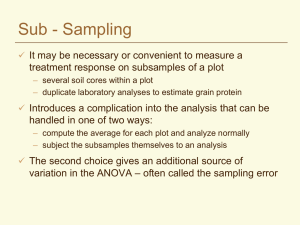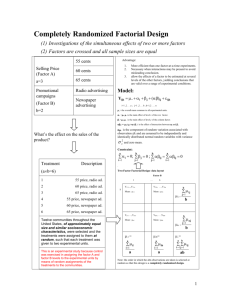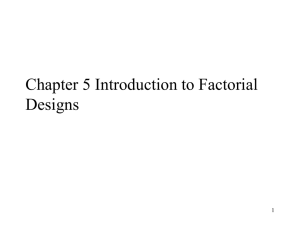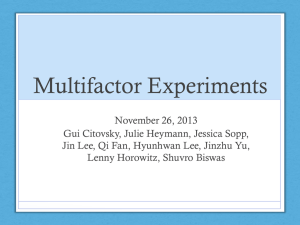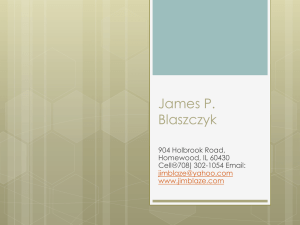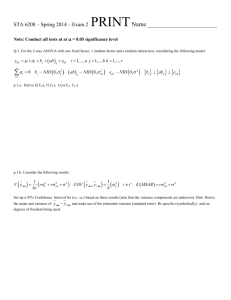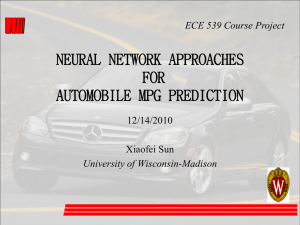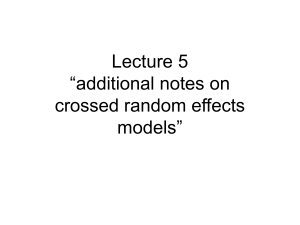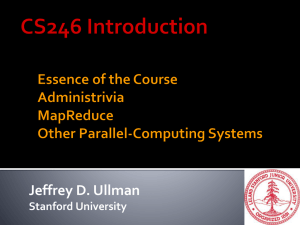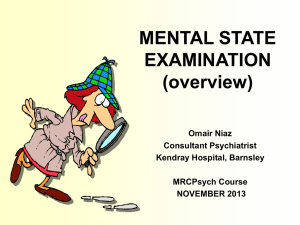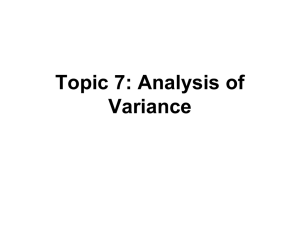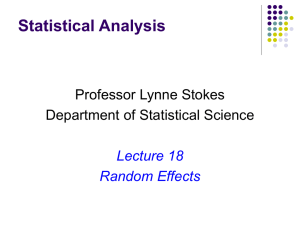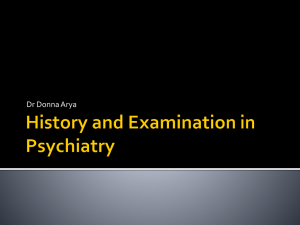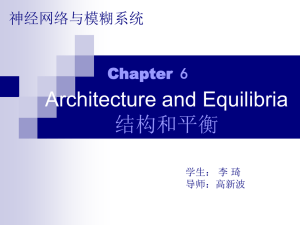KNNL-Ch19
advertisement
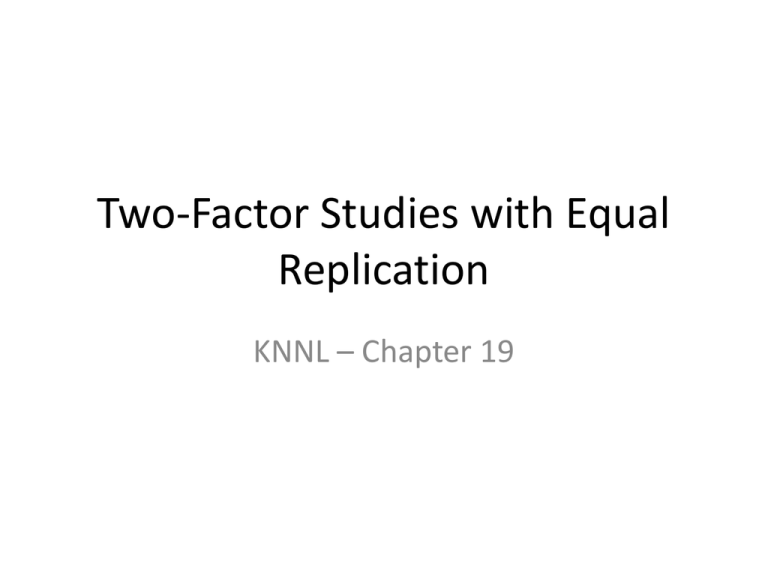
Two-Factor Studies with Equal Replication KNNL – Chapter 19 Two Factor Studies • Factor A @ a levels Factor B @ b levels ab ≡ # treatments with n replicates per treatment • Controlled Experiments (CRD) – Randomize abn experimental units to the ab treatments (n units per trt) • Observational Studies – Take random samples of n units from each population/sub-population • One-Factor-at-a-Time Method – Choose 1 level of one factor (say A), and compare levels of other factor (B). Choose best level factor B levels, hold that constant and compare levels of factor A Not effective – Poor randomization, logistics, no interaction tests Better Method – Observe all combinations of factor levels ANOVA Model Notation – Additive Model Halo Effect Study: Factor A: Essay Quality(Good,Poor) Factor B: Photo: (Attract,Unatt,None) A=EQ\B=Pic j=1: Attract j=2: Unatt j=3: None Row Average i=1: Good m11 = 25 m12 = 18 m13 = 20 m1● = 21 i=2: Poor m21 = 17 m22 = 10 m23 = 12 m2● = 13 Column Average m●1 = 21 m●2 = 14 m●3 = 16 m●● = 17 Additive Effects Model: mij m i j a b 1 a b s.t. i j 0 m mij ab i 1 j 1 i 1 j 1 b 1 b 1 b 1 mi mij m i j bm b i j m i b j 1 b j 1 b j 1 i mi m j m j m m j m j 1 a b 1 a 1 b m mij mi m j ab i 1 j 1 a i 1 b j 1 Halo Effect Example: 1 m1 m 21 17 4 1 m1 m 21 17 4 2 m 2 m 13 17 4 2 m2 m 14 17 3 1 2 0 3 m3 m 16 17 1 Mean Score versus - Essay Quality - Additive Model 30 Mean Score 25 20 15 j=1 10 j=2 5 j=3 0 1 2 Essay (1=Good, 2=Poor) Mean Score versus Picture - Additive Model 30 Mean Score 25 20 15 i=1 i=2 10 5 0 1 2 Picure (1=Attractive, 2=Unattractive, 3=None) 3 ANOVA Model Notation – Interaction Model Halo Effect Study: Factor A: Essay Quality(Good,Poor) Factor B: Photo: (Attract,Unatt,None) A=EQ\B=Pic j=1: Attract j=2: Unatt j=3: None Row Average i=1: Good m11 = 23 m12 = 20 m13 = 20 m1● = 21 i=2: Poor m21 = 19 m22 = 8 m23 = 12 m2● = 13 m●2 = 14 m●3 = 16 m●● = 17 Column Average m●1 = 21 Interaction Model: mij m i j ij a s.t. b a b i 1 i j 1 j i 1 ij j 1 ij 0 ij mij m i j mij m mi m m j m mij mi m j m Halo Effect Example: 11 23 21 21 17 2 21 19 23 21 17 2 12 20 21 14 17 2 22 8 13 14 17 2 13 20 21 16 17 0 23 12 13 16 17 0 Mean Score versus Essay Quality (A) by Picture - Interaction Model 25 Mean Score 20 15 j=1 10 j=2 5 j=3 0 1 2 Essay (1=Good, 2=Poor) Mean Score versus Picture (B) by Essay Quality - Interaction Model 25 Mean Score 20 15 i=1 10 i=2 5 0 1 2 Picture (1=Attractive, 2=Unattractive, 3=None) 3 Comments on Interactions • Some interactions, while present, can be ignored and analysis of main effects can be conducted. Plots with “almost” parallel means will be present. • In some cases, a transformation can be made to remove an interaction. Typically: logarithmic, square root, square or reciprocal transformations may work • In many settings, particular interactions may be hypothesized, or observed interactions can have interesting theoretical interpretations • When factors have ordinal factor levels, we may observe antagonistic or synergistic interactions Two Factor ANOVA – Fixed Effects – Cell Means Fixed Effects - All factor levels of interest are used in the experiment Cell Means Model: Yijk mij ijk i 1,.., a; j 1,..., b; k 1,..., n; nT abn mij mean when Factor A at level i, B at j ijk ~ NID 0, 2 Matrix Form a 2, b 2, n 2 : Y111 111 m11 111 1 0 0 0 Y m 1 0 0 0 112 112 11 112 Y121 121 m12 121 0 1 0 0 m11 Y m m 0 1 0 0 12 122 12 122 Y = Xβ + ε 122 Y211 211 m21 211 0 0 1 0 m21 Y212 212 m21 212 0 0 1 0 m22 Y m 0 0 0 1 221 221 22 221 0 0 0 1 Y222 m22 222 222 σ 2 Y = σ 2 ε = σ 2I nT Two Factor ANOVA – Fixed Effects – Factor Effects Fixed Effects - All factor levels of interest are used in the experiment Factor Effects Model: Yijk m i j ij ijk 1 a b m mij ab i 1 j 1 i 1,.., a; i mi m j 1,..., b; k 1,..., n; nT abn j m j m ij mij mi m j m m overall mean i main effect of i th level of A j main effect of j th level of B ij interaction of effect at i th level of A and j th level of B a b a b i 1 i j 1 j i 1 ij j 1 Yijk ~ N m i j ij , 2 ij ijk ~ NID 0, 2 0 independent with mij m i j ij Analysis of Variance – Least Squares/ML Estimators Notation: Observation when A @ i, B @ j , k th replicate: Yijk Sample mean when A @ i, B @ j : Sample mean when A @ i : Sample mean when B @ j : Overall Mean: Y Y ij Yij 1 n Yijk n k 1 n Y i Y 1 b n Yijk i bn j 1 k 1 bn Y j Y j 1 a n Y ijk bn an i 1 k 1 Y 1 a b n Yijk abn i 1 j 1 k 1 abn Error Sum of Squares: Q ijk Yijk mij a b n a b n 2 i 1 j 1 k 1 Q 0 mij 2 i 1 j 1 k 1 ^ Least squares (and maximum likelihood) estimators: m ij Y ij ^ Fitted values: Y ijk Y ij ^ Residuals: eijk Yijk Y ijk Yijk Y ij Factor Effects Model Estimators: ^ m ^ ^ i Y i Y Y ^ j Y j Y ^ ij Y ij Y i Y j Y Y ijk Y Y i Y Y j Y Y ij Y i Y j Y Y ij Analysis of Variance – Sums of Squares Y Y Cell Means Model: Yijk Y Yijk Y ij Y ij Y Y a b n ijk i 1 j 1 k 1 Y a 2 b n ijk i 1 j 1 k 1 Y ij 2 a b n ij Y i 1 j 1 k 1 2 SSTO SSE SSTR df E ab n 1 nT ab dfTO abn 1 nT 1 Factor Effects Model: dfTR ab 1 Yijk Y Yijk Y ij Y i Y Y j Y Y ij Y i Y j Y Y ijk i j j Yijk Y ij k i Y 2 i Y j Y 2 j k Y 2 i k Y ij Y i Y j Y k i j k SSTO SSE SSA SSB SSAB dfTO abn 1 nT 1 df A a 1 j df B b 1 df E ab n 1 nT ab df AB a 1 b 1 2 i Y 2 Analysis of Variance – Expected Mean Squares Factor Effects Model: SSE i j Yijk Y ij 2 df E ab n 1 MSE k SSA bn Y i Y 2 df A a 1 MSA i a E MSA 2 bn i 1 a 2 i a 1 SSB an Y j Y 2 2 bn mi m E MSB 2 an j 1 a 1 MSB an m j m b b 1 2 MSAB SSB b 1 2 j 1 b 1 SSAB n Y ij Y i Y j Y i SSA a 1 2 i 2 j E MSE 2 i 1 df B b 1 b SSE ab n 1 2 df AB a 1 b 1 j SSAB a 1 b 1 n ij 2 E MSAB 2 i j a 1 b 1 2 n mij mi m j m i j a 1 b 1 2 ANOVA Table – F-Tests Source df SS MS F* Factor A a-1 SSA MSA=SSA/(a-1) FA*=MSA/MSE Factor B b-1 SSB MSB=SSB/(b-1) FB*=MSB/MSE AB Interaction (a-1)(b-1) SSAB MSAB=SSAB/[(a-1)(b-1)] FAB*=MSAB/MSE Error ab(n-1) SSE MSE=SSE/[ab(n-1)] Total abn-1 SSTO Testing for Interaction Effects: H 0AB : 11 ... ab 0 mij mi m j m for all (i, j ) * Test Statistic: FAB MSAB MSE * Reject H 0 if FAB F .95; a 1 b 1 , ab n 1 Testing for Factor A Main Effects: H 0A : 1 ... a 0 mi m for all i Test Statistic: FA* MSA MSE MSB MSE No Factor A Level Effects Reject H 0 if FA* F .95; a 1, ab n 1 Testing for Factor B Main Effects: H 0B : 1 ... b 0 m j m for all j Test Statistic: FB* No Interaction Reject H 0 if FB* F .95; b 1, ab n 1 No Factor B Level Effects Testing/Modeling Strategy • Test for Interactions – Determine whether they are significant or important – If they are: If the primary interest is the interactions (as is often the case in behavioral research), describe the interaction in terms of cell means If goal is for simplicity of model, attempt simple transformations on data (log, square, square root, reciprocal) • If they are not significant or important: Test for significant Main Effects for Factors A and B Make post-hoc comparisons among levels of Factors A and B, noting that the marginal means of levels of A are based on bn cases and marginal means of levels of B are based on an cases Factor Effect Contrasts when No Interaction a Contrasts among Levels of Factor A : L ci mi i 1 a ^ c i 1 i 0 ^ Estimator: L ci Y i Estimated Standard Error: s L i 1 1 100% CI for L : a MSE a 2 ci bn i 1 L t 1 2 ; ab n 1 s L ^ ^ ^ Scheffe' Method for Many (or data-driven) tests: L a 1 F 1 ; a 1, ab n 1 s Bonferroni Method for g Pre-planned Tests: L t 1 / 2 g ; ab n 1 s L ^ ^ ^ 1 Tukey Method for all Pairs of Factor A Levels: L q 1 ; a, ab n 1 s L 2 ^ Similar Results for Factor B, with a and b being "reversed" in all formulas: b L c j m j j 1 b c j 1 j 0 ^ b L cjY j j 1 ^ s L MSE b 2 cj an j 1 ^ L Factor Effect Contrasts when Interaction Present a b Contrasts among Cell Means : L cij mij i 1 j 1 ^ a b Estimator: L cij Y ij a c i 1 j 1 ij 0 ^ Estimated Standard Error: s L i 1 j 1 1 100% CI for L : b MSE a b 2 cij n i 1 j 1 L t 1 2 ; ab n 1 s L ^ ^ ^ Scheffe' Method for Many (or data-driven) tests: L ab 1 F 1 ; ab 1, ab n 1 s Bonferroni Method for g Pre-planned Tests: L t 1 / 2 g ; ab n 1 s L ^ ^ ^ 1 Tukey Method for all Pairs of Treatment Means: L q 1 ; ab, ab n 1 s L 2 ^ ^ L
